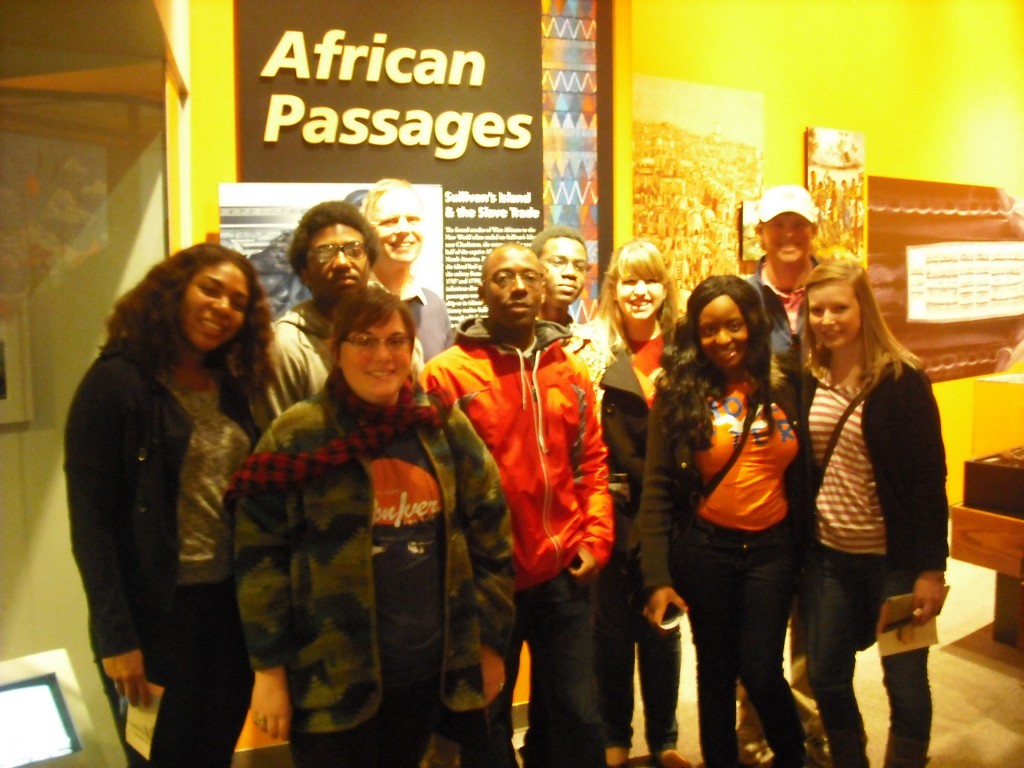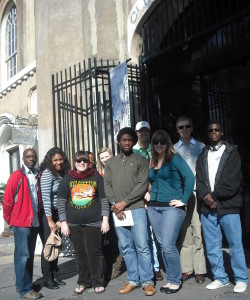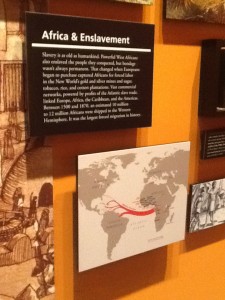
The Seminar group poses at Sullivan’s Island
French Professor Jay Lutz and I designed a First Year Seminar course called “Eyes on Africa.” The seminar explores the culture, literature, people and current events related to the African continent, as well as relevant connections to the African Diaspora—the manifestation of African culture outside of the continent. This manifestation includes Africa’s indelible impact on the United States through the influence of black Americans.
In exploring the rich contribution of Africans on the United States, we thought it appropriate to take our class on a journey to Charleston, South Carolina, the historic city many call “ground zero” of African American culture in the United States. Charleston has this designation because as the fifth largest city in late 17th century colonial North America it was a major slave port, receiving tens of thousands of African men and women destined to toil in South Carolina plantations, rice fields, and urban centers. Moreover, it is estimated that more than half of all African Americans, no matter where in the U.S. they reside, had at least one ancestor who was trafficked through the Charleston port.

Students visited the Old Slave Mart Museum.
Our FYS had the privilege of being escorted throughout much of our Charleston tour by South Carolina historian and author Wayne Anthony O’Bryant, who was generously gave the entire FYS an autographed copy of his book, In the Footprints of a Giant: The Vesey Connection, which traces Denmark Vesey’s life and legacy through the author’s childhood recollections and revelations.
Our seminar group visited and learned about the domestic and international slave trade at Charleston’s Old Slave Mart Museum. Originally Ryan’s Mart, this very building held slave auctions where men, women and children were bought, sold and traded. The museum has sobering exhibits focused on the institution of slavery and its importance to the economy and general development of colonial South Carolina. The black population of colonial South Carolina frequently equaled or exceeded that of whites, which permitted a thorough diffusion of African culture, art, music, dance, architecture, craft, cuisine, spirituality, and even language in the region and beyond. Some of the most significant slave insurrections in colonial America, including the Stono Rebellion of 1739 and the Demark Vesey’s famous revolt of 1822 occurred in or around Charleston.
We also toured the Avery Research Center for African American History and Culture. Founded in 1865 by the American Missionary Association as the Avery Normal School, this institution, for nearly a century, groomed Charleston area African Americans for professional and academic careers until its doors closed in 1954. Today, the Avery is not only a research center, but also an archives and a museum containing valuable historical documents related to local African American culture as well as to the African diaspora.
Our group also traveled to Columbia, S.C., where we visited the African American Monument, the first and only monument dedicated to African American culture built on the grounds of a state capitol. The granite and bronze monument sculpted by Ed Dwight opened in 2001 and uses a series of expressive panels to trace African American culture from the arrival of Africans to South Carolina shores to the present.

A map at Sullivan’s Island shows the path of slaves from Africa to the Americas.
Before returning to Oglethorpe, our FYS explored Sullivan’s Island, a place with significant historical significance despite its relatively low-key status as a Charleston-area landmark. A major battle of the American Revolution took place at Fort Sullivan (now Fort Moultrie). However, prior to becoming a Revolutionary-era battleground site, for much of the 18th century, Sullivan’s Island served as a “quarantine station” for Africans arriving in the United States before beginning their new lives as slaves. It is estimated that 40% of African Americans can trace an ancestors through Sullivan’s Island, making this sacred site akin to an “African-American Ellis Island.”
Dr. Mario Chandler is Associate Professor of Spanish. He received his B.A. from Iowa State University, and his M.A. and Ph.D. from The University of Georgia.
